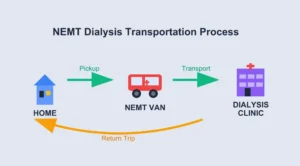As the summer months roll in, Non-Emergency Medical Transportation (NEMT) providers face a significant spike in demand. This season brings unique challenges in managing transportation for medical appointments, treatments, and other essential services. For NEMT providers, it’s essential to be prepared for these high-volume periods to ensure that patients receive timely and efficient service
Why NEMT Demand Increases in Summer
- Seasonal Health Treatments: Another way that patients use to how to get a taxi is during summer season where they are seasonal customers undergoing physical therapy or cancer treatments, which requires them to travel regularly. During this time of year hospitals and clinics observe the increase in the number of appointments, which makes NEMT services more in demand.
- School Breaks and Family Travel: Many members of a family would be traveling or on holiday especially in the time of summer creating a shortage on the means of transport left to the patients. The NEMT providers would come in to make sure that such patients do not miss their essential medical visits.
- Weather-Related Mobility Issues:While summer may signify pleasant sun and warmth, it’s also associated with water and heat shocks, frying the body temperature as well as swelling up. Such weather can have an impact on those people dependent on public transportation, more so they rely on NEMT services.
- Increased Health-Related Incidents: It is common during hot summer months to experience more incidences of health related problems like heat related illnesses and chronic diseases like asthma, dehydration, or respiratory problems. These patients will need an increased rate of transferring to medical centers, and emergency clinics are to be primarily considered.
Effective Strategies to Manage High NEMT Volume
- Optimize Scheduling Systems
The process of high volumes in a summer needs to be supported by a powerful scheduling system. Apply real-time scheduling softwares which are flexible to hearing last minute reservations and cancellations. Both drivers and patients are preventable by automated notifications in order to minimize the no-show and automate the process. - Hire Temporary Staff
During peak seasons, temporary drivers or administrative staff can provide relief to full-time teams. These new hires can help meet the demand without sacrificing service quality. Ensure they are well-trained to meet patient care standards and familiarize them with company protocols. - Leverage Technology for Route Optimization
The optimization of routing is important during high-volume time. Install GPS and route optimization system, to streamline delays and cut-down on fuel expenses and see to it that the patients find their way in as safely and efficiently as possible. This has the potential of enhancing the operations efficiency of your fleet particularly where there are several appointments within a day. - Offer Flexible Pick-Up Times
Allowing patients more flexibility in their pick-up times can help spread out the demand throughout the day, reducing bottlenecks. This also allows driver shifts to be better optimized and ensures no single time slot becomes too congested. - Plan for Weather Challenges
Prepare for unpredictable weather by ensuring your vehicles are equipped to handle extreme heat, rain, and humidity. Provide extra cooling for vehicles, and always have backup plans in place for patients who may need emergency rides due to weather-related issues. - Maintain Clear Communication with Patients
A good communication with the patients is important in having a smooth operation during the high demand period. Send reminders via phone calls, text messages, or via emails to confirm the appointment, notify them of possible delays, or make the necessary adjustments to their schedules. - Monitor Performance Metrics
Keep track of operational metrics such as response times, ride times, and patient feedback. Data-driven decisions allow you to make adjustments in real time and continually optimize your service delivery.
Conclusion: Stay Ahead of the Summer Rush
Since the NEMT demand is significant during summer, it is necessary to adjust to the circumstances promptly and effectively. It is quite possible to handle high volume traffic without compromising quality of service by using proper scheduling tools, streamlining routes, increasing your workforce, and communicating thoroughly to the drivers and the patients.




